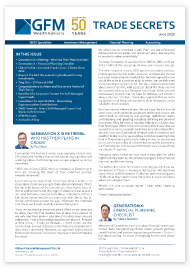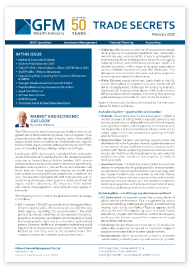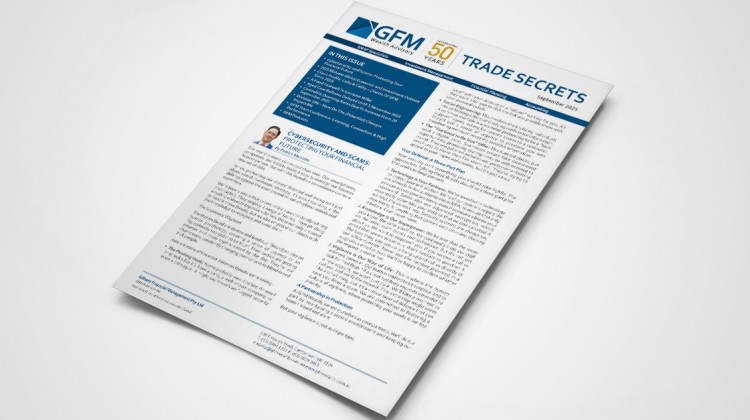
TRADE SECRETS
IN THIS ISSUE
- Cybersecurity and Scams: Protecting Your Financial Future
- 2025 Midyear Global Economic and Investment Outlook
- Client Profile: Colin & Cathy – Clients Of GFM Since 2019
- A Fond Farewell To Lorraine Miller
- Aged Care Reforms Delayed Until 1 November 2025
- Centrelink Deeming Rates Due To Increase From 20 September 2025
- Division 296 – How Do The (Potential) Changes Impact Me
- GFM Team Conference: Learning, Connection & High Performance
- GFM Podcasts

Cybersecurity and Scams:
Protecting Your Financial Future
By Patrick Malcolm
The world is more connected than ever. Our smartphones, computers, and tablets make it easy to manage our finances from anywhere. But with this incredible convenience comes a new set of risks.
For us, protecting our clients’ financial well-being isn’t just about sound investment strategy; it’s about assisting in the defence against the ever-present threat of cybercriminals and scammers.
We’re keenly aware that cybercriminals are constantly refining their tactics. They employ a range of tactics, from phishing emails to elaborate imposter schemes. We’re not only prepared to handle these threats, but we also empower our clients with the knowledge to recognise and avoid them.
The Scammers’ Playbook
The threats faced are diverse and insidious. They often play on human psychology, creating a sense of urgency or an “opportunity too good to be true”. Their tactics are getting smarter and more sophisticated by the day. They’re like chameleons, constantly changing their colours to blend in and trick people.
Here are some of the most common threats we’re seeing:
- The Phishing Hook: You’ve probably seen it before. An email that looks like it’s from a bank, a well-known company, or even a colleague. It might say there’s an “urgent security issue” with your account or a “refund” waiting for you. All they want is for you to click the link and provide them with your personal details.
- Social Engineering: This involves manipulating individuals into performing actions or divulging confidential information. A common example is a scammer pretending to be a “tech support” agent, asking for remote access to a computer. They’ll use a sense of urgency to pressure you into transferring money or revealing sensitive information.
- The “Too Good to Be True” Offer: This is an old classic, just with a digital twist. Scammers create fake investment opportunities, promising sky-high returns with minimal to no risk. They use polished websites and professional-looking brochures to make their lies seem real. They’re trying to appeal to your hopes and dreams, but it’s just a trap.
Your Defence: A Three-Part Plan
Your security isn’t something you should take lightly. The approach to fighting these threats should be a three-part plan that works to keep you safe.
- Technology is Your Fortress: We’ve invested in technology to protect your information. Many of our partners require the use of multi-factor authentication (MFA) to ensure that only you can access your accounts, even if someone obtains your password. Some also use advanced encryption, which essentially scrambles your data so that no one can read it without the correct key. Security systems are always on, monitoring for anything that appears suspicious and blocking it before it can cause harm.
- Knowledge is Our Superpower: We believe that the more you know, the safer you’ll be. We continually train our staff on the latest scam tactics and techniques. But it’s not just about us. We want to empower you. If you receive a call or email that seems suspicious, don’t hesitate to question it. The best thing you can do is hang up and call us directly at our office number. Never use the number provided in a suspicious email or text. We’ll be happy to confirm whether the request is real or not.
- Vigilance is Our Way of Life: This is where the human element comes in. Our team is trained to be sceptical and to look for “red flags.” If a client suddenly requests a transfer to a new account, we won’t just do it. We’ll take a moment to call you and verify the request. This extra step might seem like a small thing, but it’s a critical layer of defence that can save you from a scam. We are committed to fostering a culture of vigilance, where protecting your assets is our top priority.
A Partnership in Protection
At GFM Wealth, we see ourselves as your partners. We’ll do our part by maintaining a secure environment and keeping our team trained and alert.
But your vigilance is just as important.
Here’s how you can help:
- Think Before You Click: Recognising and Resisting Phishing
The first and most important line of defence is your own caution. Cybercriminals often use phishing to trick you into giving away personal information. Phishing emails and messages are designed to create a sense of urgency, surprise, or an offer that’s too good to be true.
- Urgency: “Your account will be suspended in 24 hours if you don’t click here to verify.”
- Surprise: “There has been an unauthorised login from a new device. Click to secure your account.”
- Too Good to Be True: “Congratulations! You’ve won a holiday. Just enter your bank details to claim your prize.”
Always pause and question the message’s intent. Scammers use these tactics to get you to act without thinking.
- Verify, Verify, Verify: The Power of a Trusted Contact
If you receive a suspicious email, SMS, or even a phone call, do not rely on the contact information provided in the message itself. Cybercriminals can fake phone numbers and email addresses.
Instead, always use a trusted, known phone number to contact your adviser directly. Use the number you have on file, found on our official website, or a business card you know is legitimate. A quick phone call is the most effective way to confirm any requests, changes, or instructions. This simple step can prevent a significant financial loss.
- Keep Your Guard Up: The Basics of Digital Hygiene
Your online habits play a crucial role in protecting your personal and financial data.
- Use Strong, Unique Passwords: Never reuse the same password for multiple accounts. A strong password should be a combination of upper- and lowercase letters, numbers, and symbols. Consider using a password manager to help you create and securely store unique passwords.
- Be Cautious When Using Public Wi-Fi: Avoid accessing sensitive accounts, such as your bank or investment portals, while connected to public Wi-Fi networks. These networks are often unsecured and can be easily monitored by malicious actors.
- Secure Your Devices: Ensure your computer and smartphone have up-to-date antivirus software and are protected by a password, PIN, or biometric lock.
By being vigilant and adopting these simple security practices, you can significantly reduce your risk of becoming a victim of cybercrime.
We are committed to protecting your financial well-being and are here to help if you ever have a security concern.

Midyear Global Economic and Investment Outlook
By James Malliaros
The first half of 2025 was marked by significant market turbulence due to the potential for a tariff-driven trade war. Despite a sharp selloff in April, markets have since recovered to historic highs after the “liberation day” tariffs sent global markets into a tailspin. The near-term outlook, however, remains uncertain due to ongoing trade policy, geopolitical risks, inflation, and interest rate trends.
Global Economic Outlook
The world is shifting towards deglobalisation, which is reconfiguring the global trading system and will have profound effects on financial markets. Tariffs are expected to lead to higher inflation and slower economic growth, a trend already visible in the US manufacturing sector. This deceleration is expected to continue in the second half of the year. The US Federal Reserve (Fed) is likely to be cautious about lowering interest rates due to the risks of stagflation, characterised by high inflation and low economic growth.
Measure of risk aversion in the US Stock Market
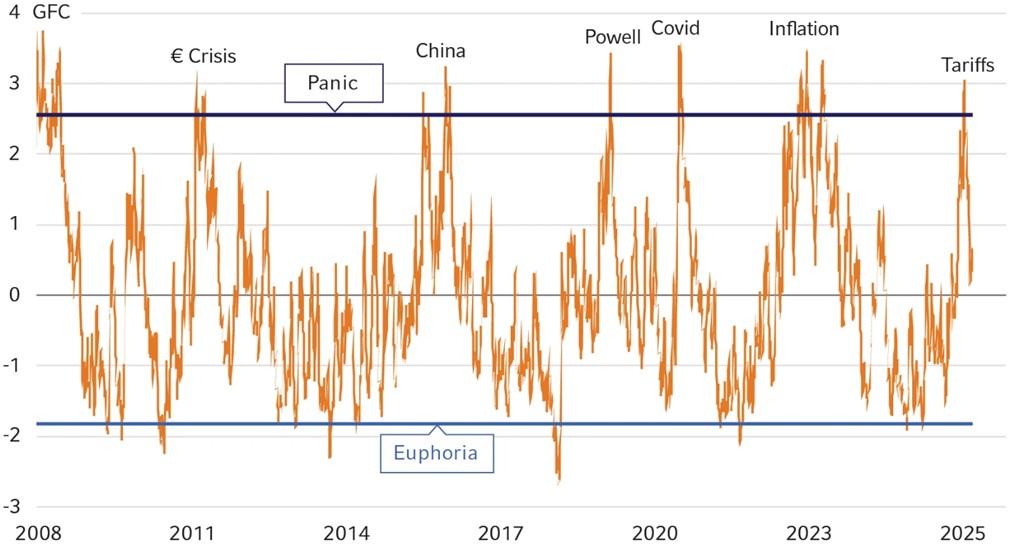
Source: Russell Investments – June 2025
Across the Atlantic, a massive multi-year stimulus package in Germany has the potential to reinvigorate Europe, with an estimated doubling of economic growth in 2026 and 2027. The Eurozone is poised for modest growth, underpinned by recovering bank lending, easing energy costs, rising defence spending, and monetary policy easing.
For China, the outlook improved after the US lifted embargo-level tariffs in mid-May. China has responded cautiously to the tariff threats, reorienting its trade away from the US and toward emerging markets. While underlying economic conditions remain weak, the property market is showing early signs of improvement, and policymakers are expected to provide fiscal support to meet their “around 5%” growth target for 2025.
China exports to the US, % of total China exports
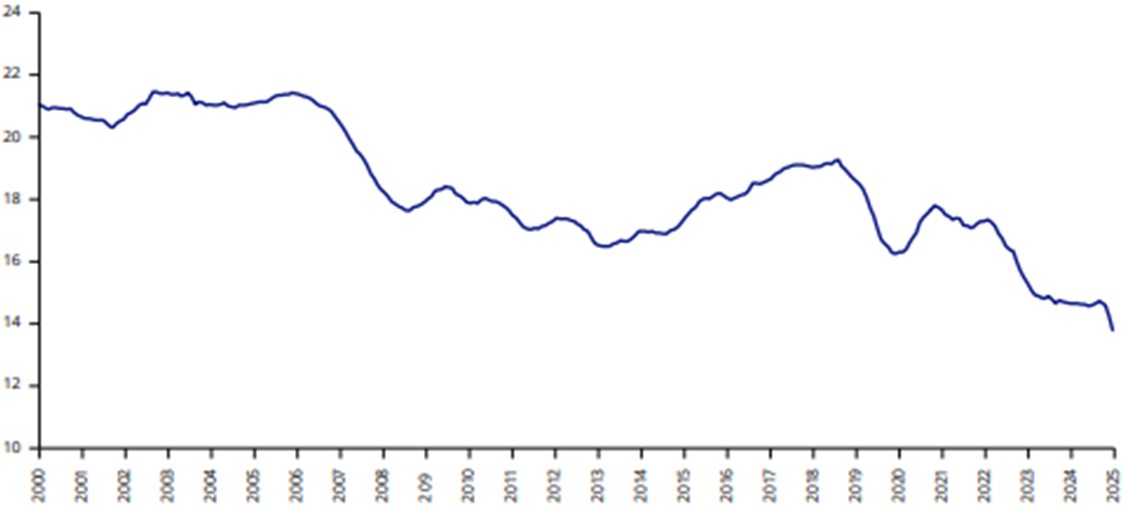
Source: Bloomberg – June 2025
Australian Macroeconomic Outlook
In Australia, the Reserve Bank of Australia (RBA) is now firmly in easing mode, having lowered the cash rate to 3.85% in May. The RBA further cut rates in August. The RBA has signalled that its primary concern is now economic growth and the risk of weakness in the labour market, rather than resurgent inflation. With inflation now within the target range, monetary conditions can be loosened to support economic growth in 2025.
However, the fragmentation of global trade poses a significant structural risk for Australia, as it could interrupt decades of falling interest rates and inflation. An unexpected upside could be increased policy ambition from the newly elected government to address weak productivity by tackling rising labour-to-capital ratios.
Growth in per capita stock & productivity
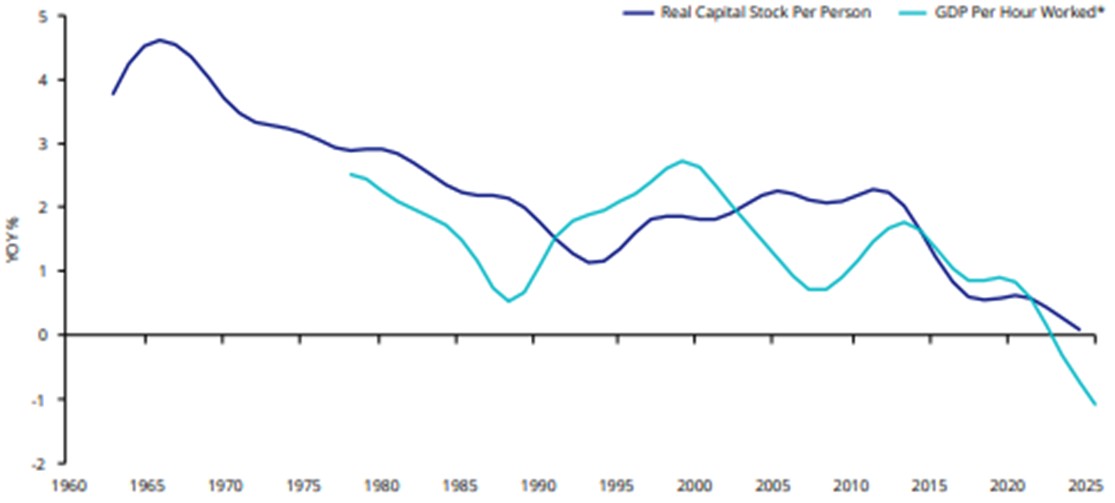
Source: ABS, Melbourne Institute – June 2025
Global Investment Market Outlook
The global equity landscape is undergoing a fundamental shift, with the era of US market dominance facing challenges. Given that US market valuations have returned to historic highs and the economy is vulnerable to stagflation, a strategic pivot away from overvalued US markets toward international opportunities is recommended. Europe, bolstered by German fiscal stimulus and attractive valuations, is an emerging opportunity. Emerging markets also present attractive opportunities, characterised by strong fundamentals.
The outlook for the US dollar is negative. From a valuation perspective, the dollar’s real trade-weighted exchange rate is near the top of a 50-year range. Cyclical forces that supported US outperformance are reversing, as US policies are likely to dampen economic growth, while policies in the rest of the world are generally moving to support stronger economic activity. This outlook for a weaker dollar amplifies the case for a globally diversified portfolio.
Trade–weighted US Dollar Index, 1980–present
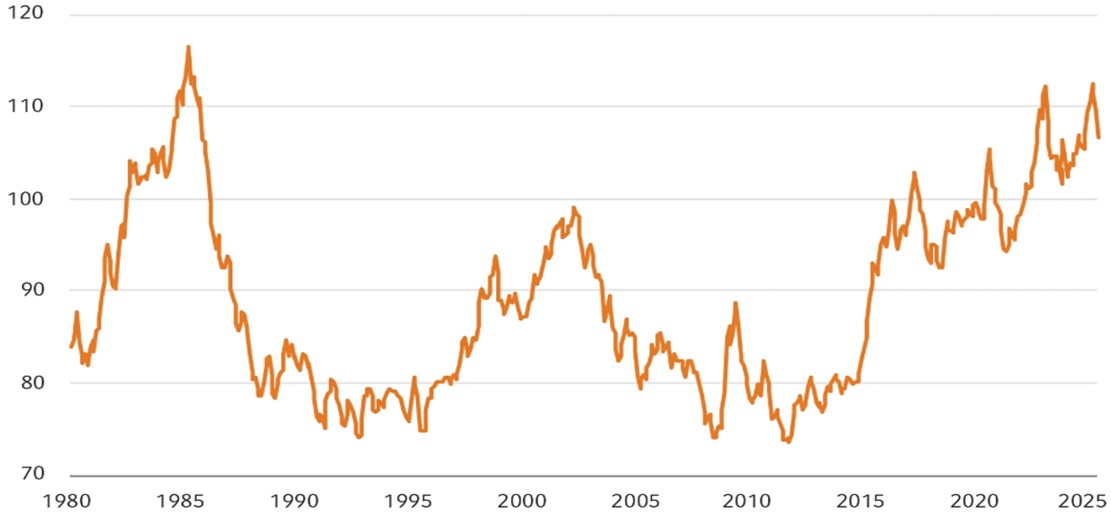
Source: BIS, Russell Investments – April 2025
Australian Investment Market Outlook
Australian equities are currently overvalued but represent a good defensive market due to a high dividend payout ratio. The Australian market is more concentrated than the S&P 500, with CBA and BHP accounting for approximately 19% of the ASX 200. While this concentration carries risk, the significant stock concentration in banks also serves as a safety net, as approximately 47% of the stock is held by retail investors who are locked into receiving their dividends biannually.
Similar to the US market, the ASX 200 is overvalued (12–month forward PE ratio)
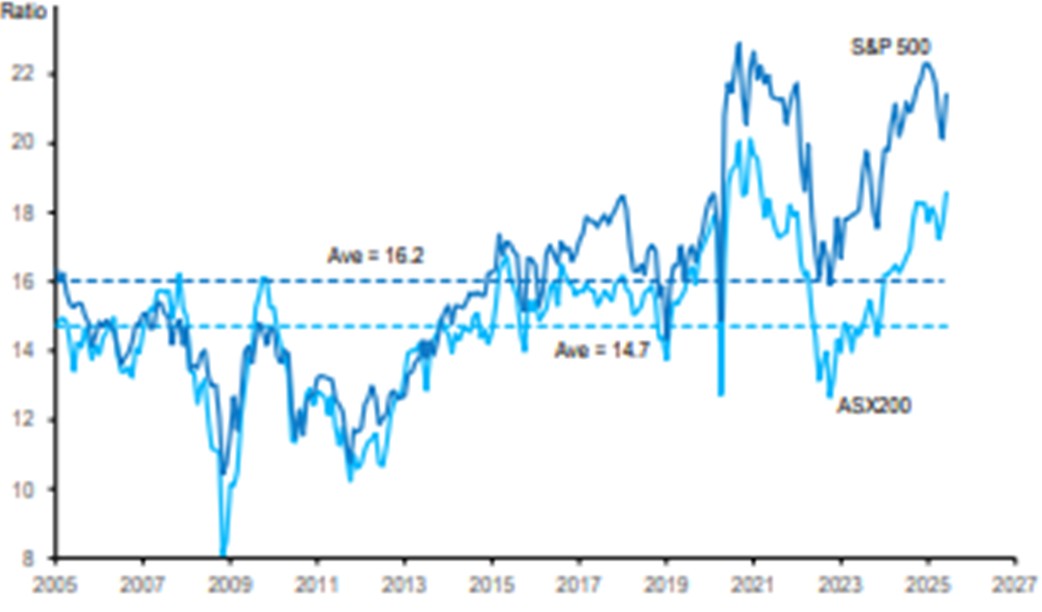
Source: FactSet, MWIM Research – June 2025
Australia’s high payout makes it a good defensive market.(Payout ratios)
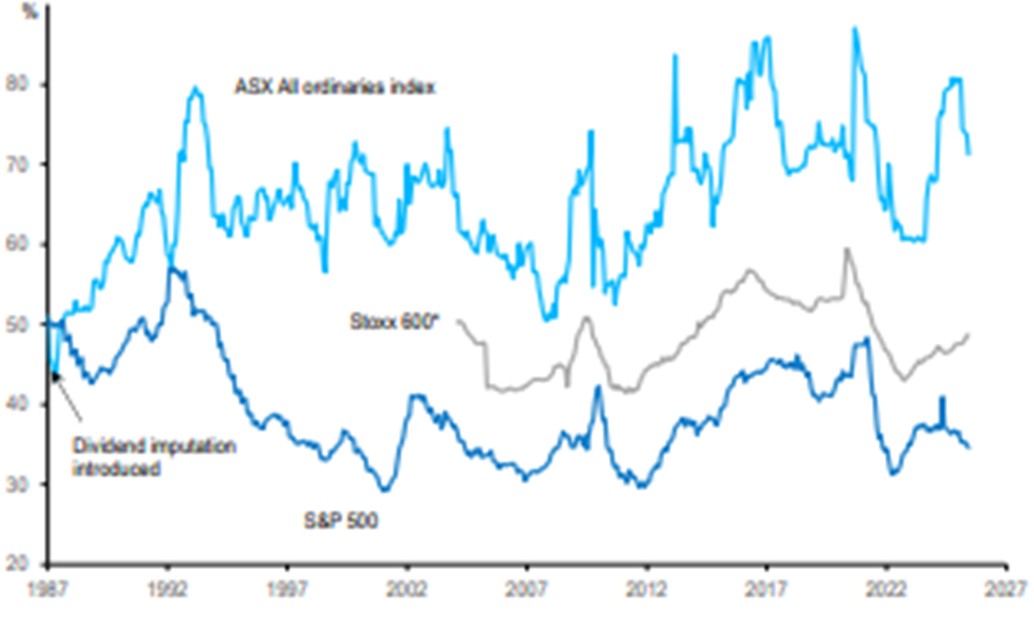
Source: FactSet, MWIM Research – June 2025
Concluding Comments
The market rally since April has been impressive and may continue into the second half of the year. However, the recent turbulence serves as a reminder for investors to strengthen their portfolios through diversification across all asset classes. After a period of US market dominance and AI-driven earnings growth, it is now time to consider diversifying away from the US due to historically high valuations. Being more conservative and avoiding exuberance will be crucial for the period ahead.

Colin and Cathy:
CLIENTS OF GFM SINCE 2019
By Amelia Paullo

Colin kindly wrote the article on their working life, retirement, and relationship with GFM Wealth Advisory. We greatly appreciate his contribution to Trade Secrets.
In the early 70’s, Cathy and I met while working at the new-to-Australia Target Discount Chain, and we married in 1973. Cath spent the next 44 years working in various administrative roles in retail, while I moved into Sales and Marketing in the Plastics Industry.
Having both grown up in the Western Suburbs, Cath in Sunshine and me in Williamstown, we bought our first home in the new satellite city of Melton. Unlike today’s first homes, it was only 12 square. We intended to live there until we had a family, when we would move into something bigger and better. However, despite spending a lot of time and money on the new IVF procedures, we never managed to have children, so despite having done extensions and numerous renovations, 50 years later, we still live in our original home.
Not having family obligations, we were able to travel overseas quite extensively both through work and privately, quite often with friends, and had the privilege of experiencing many of the great wonders this world offers, including Cath’s favourite (being an animal lover), several safaris in various parts of Africa.
When we retired a few years ago, we upgraded our caravan and began spending three months a year chasing the warmth, enjoying the marvellous country we are lucky to live in. I might add that Australia can hold its head high, having features and animals equal to those of anywhere else in the world.
Sometimes when you travel, you can be lucky. Cath and I had decided to do the West Coast when COVID reared its ugly head, we left Melbourne two days before “lock down” started and got into WA before their lock down and we happily spent six months touring the West without any indication there was any medical emergency, to the extent that when we called into Kalgoorlie Hospital for a booster shot they weren’t even wearing masks!
Although between us, we worked for 94 years, like several workers of our age, we never started superannuation until reasonably late in our working lives. So, when the opportunity came to buy into the company I worked for, I jumped at the chance. With a combination of salary sacrifice and company dividends, we saved enough, and through our accountant, we set up an SMSF.
However, we soon found out that using accountants as financial advisors does not necessarily produce the best results, and we were disappointed with the performance of our SMSF portfolio. I was having a whinge about this to a friend, Ralph Hermann, one night, and he told us about the company he and others from Qantas used, GFM, and particularly Patrick Malcolm.
I must admit that taking advice from a Carlton supporter made me nervous, but I decided to give it a go. Patrick soon straightened out some of our problems. However, I think it was just after he found out we were Western Bulldogs supporters that he suggested we work with Amelia Paullo, which we have done happily and successfully ever since. We have been much happier with the results of our SMSF portfolio due to Patrick and Amelia.
I want to extend a huge “congratulations and thank you” to all the staff at GFM, who are not only incredibly skilled at what they do but also do it in such a friendly and positive manner. We look forward to our annual visit to Camberwell, which allows us to spend quality time with the team at GFM. We always enjoy the visit and the time spent with the team.

A fond farewell to Lorraine Miller
By Paul Nicol

It is with a mixture of happiness and heartfelt gratitude that we announce the retirement of a cornerstone of the GFM Wealth Advisory team, Lorraine Miller. For over 20 years, Lorraine has been a silent force behind the scenes, ensuring that our operations ran smoothly and our client data was accurate.
Since joining us in 2001, Lorraine has worn many hats, but in recent times, she has been an indispensable Project Manager. She is an expert behind the scenes, masterfully managing and maintaining our internal databases—XPLAN and CommPay—and helping us stay ahead of constant changes in financial regulations. Her skill with these software packages is renowned, and she has consistently ensured our firm maintains the highest standards of data integrity and operational efficiency.
On behalf of the entire GFM team, we would like to thank Lorraine for her dedication and outstanding contribution.
We wish her a long, happy, and well-deserved retirement.

Aged Care Reforms delayed until 1 November 2025
By Karen Maher
The start date for the new Aged Care Act has been pushed back to 1 November 2025, including the related grandfathering arrangements. This delay gives the government more time to finalise the rules and help aged care providers prepare.
Legislation for the Act was passed on 25 November 2024, to enhance support for older Australians receiving care at home or in residential aged care facilities. It also focuses on making the aged care system more sustainable as government spending increases.
Residential Aged Care
From 1 November 2025, new residents entering residential aged care will be subject to the new fee arrangements.
Residents who enter before 1 November 2025 will be covered by grandfathering rules under the “no worse off” principle.
Changing Rooms or Facilities After 1 November 2025
Residents who move after 1 November 2025 can keep their current fee structure if:
- The move is involuntary (e.g. care needs change and the provider can’t meet them) or
- The move is voluntary, and the resident has not:
- Chosen to be assessed under the new rules, or
- Been out of aged care for 28 days or more (excluding approved leave)
Approved leave includes hospital leave, emergency leave, hospital transition leave or social leave (up to 52 days).
If a resident leaves aged care for more than 28 days (excluding approved leave), they will be reassessed under the new rules upon their return.
Home Care Package (HCP) Recipients Moving into Residential Care
If a recipient was receiving or eligible for a HCP as at 12 September 2024, they are considered a grandfathered HCP recipient.
When these recipients move into residential care after 1 November 2025, they will:
- Stay on the existing fee structure, including:
- Means–tested fee (MTF)
- MTF lifetime cap
Unless they choose to switch to the new system, which includes:
- Hotelling contribution
- Non–clinical care contribution (NCCC)
- NCCC lifetime cap
However, accommodation payments will change for all new residents, including those who are grandfathered HCP recipients. These changes include:
- Retention amount deductions
- Indexed daily accommodation payments
Recipients who are not classified as grandfathered HCP recipients will be assessed under the new fee and accommodation rules.
Home Care Package Moving to Support at Home program
The Support at Home program is a new model replacing Home Care Packages from 1 November 2025, designed to streamline services and improve flexibility for older Australians receiving care at home.
Recipients assessed for a HCP before 1 November 2025 will fall into one of two categories:
- Grandfathered HCP recipients (as at 12 September 2024)
- Transitioned HCP recipients (approved or on the National Priority System between 13 September 2024 and 31 October 2025)
Grandfathered HCP Recipients
These recipients will transition to the Support at Home program under the ‘no worse off’ principle. They will:
- Continue paying current or lower fees, even if reassessed to a higher Support At Home program classification
- Carry over unspent HCP funds (up to $1,000 or 10% of the quarterly budget, whichever is greater)
- Use these funds only after the quarterly budget and any restorative or end-of-life funding is used
- Use unspent HCP funds before accessing Assistive Technology and Home Modifications (AT–HM) funding
Transitioned HCP recipients
These recipients:
- Were approved or on the National Priority System between 13 September 2024 and 31 October 2025, but hadn’t started receiving HCP support
- Started receiving a HCP from 13 September 2024 and will transition to the Support At Home program from 1 November 2025
They must sign a new service agreement with their provider. Services must match the Support At Home program services list and meet their care needs.
All HCP recipients will move to the Support at Home program from 1 November 2025, keeping the same level of funding and retaining any unspent funds.
Recipients approved for a HCP as of 31 October 2025 will receive a Support At Home program budget equivalent to their approved package. If reassessed and a higher level of funding is needed, it will be provided under the Support At Home program classification.
Please refer to previous editions of Trade Secrets for a breakdown of the key changes to Residential Aged Care, Home Care Packages and the Commonwealth Home Support program.

Centrelink Deeming Rates Due to Increase From 20 September 2025
By Rebecca Dhillon
On 20 August 2025, the Minister for Social Services, Tanya Plibersek, announced upcoming changes to Centrelink deeming rates, effective from 20 September 2025.
What Are Deeming Rates?
Centrelink uses deeming rates to calculate the income generated from financial assets such as bank accounts, shares and superannuation. These rates help determine eligibility and payment amounts for income–tested benefits, such as the Age Pension and Low Income Health Care Card. The system assumes these assets earn a set rate of income, regardless of actual returns.
Since May 2020, deeming rates have been frozen at historically low levels to support pensioners and income support recipients during the COVID–19 recovery. The rates are typically influenced by the Reserve Bank of Australia’s (RBA) official cash rate.
Why Are Rates Changing?
With inflation easing and economic conditions improving, the government plans to return deeming rates to pre–pandemic settings gradually. The goal is to reflect realistic returns that pensioners and other recipients can reasonably earn on their investments.
New Deeming Rates from 20 September 2025
| Category | Asset Threshold | Current Rate | New Rate |
| Single | First $64,200 | 0.25% | 0.75% |
| Above $64,200 | 2.25% | 2.75% | |
| Couple (combined) | First $106,200 | 0.25% | 0.75% |
| Above $106,200 | 2.25% | 2.75% |
Even with these increases, deeming rates will remain below historical pre–COVID averages.
Centrelink applies both the income and assets tests and uses whichever one results in the lower payment. If you have significant assets but a low income, you are likely to be assessed under the assets test and may not be affected by deeming rate changes. However, if your income is the limiting factor (for example, if you have a significant income from a defined benefit pension), then a change in deeming rates could affect your payment.
People with assets that are just below the assets test cut-off points can also find themselves being assessed under the income test instead. This happens because their total assets are below the assets test threshold for a part-pension, but their deemed income from those assets is still high enough to reduce their pension. Many people in this situation may not realise they are being income-tested. They may believe that as long as they are below the assets test cut-off, their pension is secure.
Future Oversight
The Australian Government Actuary will now be responsible for recommending future deeming rates. These recommendations will be based on accessible investment returns, ensuring fairness and transparency. The government will retain the ability to adjust rates during exceptional circumstances.

Division 296 – How do the (potential) changes impact me?
By Sam Eley
The Labor Government’s new Division 296 tax, a controversial measure, introduces higher tax rates for those with balances exceeding the $3 million threshold, including the potential for taxation on unrealised capital gains.
Now that we have passed 1 July 2025, although it is not yet legislated, technically, the clock has started ticking for those with higher member balances in their Superannuation Fund.
Impacted members are:
- Individuals with a total superannuation balance (TSB) across all superannuation accounts held by the member that exceeds $3 million
- A couple can still have up to $6 million in superannuation before being impacted, provided an equal split with no one member exceeding $3 million
- Defined benefit interests will be included; however, specific rules will apply as to how this tax is calculated and payable
What is the method of calculating the potential tax liability?
- For members with a TSB over $3 million at the end of the financial year (e.g. 30 June 2026), a 15% tax is proposed to be levied on the movement between the member’s opening and closing total balances for the year (after adjusting for withdrawals, contributions, and other specific exclusions listed above). This movement is referred to as the ‘earnings’ amount.
- The mechanism further ensures that the additional tax is only calculated on the proportion of assets over the $3 million balance.
The calculation method is as follows:
Step 1: Calculation of Earnings
Earnings = (TSB of the current financial year + Withdrawals – Net Contributions) – TSB of the previous financial year
Step 2: Calculate the proportion of earnings attributable to balances > $3 million
Proportion of Earnings = (TSB of the current financial year – $3 million) / TSB of the current financial year
Step 3: Calculate tax liability
Tax Liability = 15% x Earnings x Proportion of Earnings
Case Study:
Jane has a TSB of $3.3m as at 1 July 2025. Throughout FY26, she withdraws $100,000 from her fund, and the fund has a closing TSB as of 30 June 2026 of $3.5 million. She made no contributions during the financial year.
- TSB at 1 July 2025: $3,300,000
- TSB at 30 June 2026: $3,500,000
- Withdrawals: $100,000
- Contributions: $0
- Earnings: ($3,500,000 + $100,000 – $0) – $3,300,000 = $300,000
- Proportion of TSB above the $3m threshold: ($3,500,000 – $3,000,000) / $3,500,000 = 14.29%
- Taxable Earnings: $300,000 x 14.29% = $42,870
- Division 296 Tax: $42,870 x 15% = $6,431
This tax will be levied on the individual member, not the superannuation fund. The ATO will issue an assessment to the member personally to levy this additional 15% tax, with the member then able to elect whether to pay this personally or withdraw it from their Superannuation fund.
When will Division 296 come into effect?
The Division 296 tax Bill has not yet been passed into law. Assuming the measure passes through Parliament, the first assessment for Division 296 will be based on an individual’s TSB at the start and end of the 2025/26 financial year.
Until Division 296 actually becomes law, though, the exact contents of the Bill and the function of the tax could change.
What are some of the issues with this tax?
Given the member’s TSB includes unrealised gains and losses, this will mean that the 15% tax will also be calculated on movements in unrealised asset valuations during the relevant year. This could cause cash flow problems for funds with less liquid assets, as the tax has to be funded on assets that have yet to realise their value.
Additionally, if there are negative earnings during a financial year, the loss will be carried forward to offset future earnings. There is currently no mechanism to carry back a negative earnings amount when, in one financial year, an unrealised gain (and tax is levied) occurs, and in a future year, a loss occurs.
Currently, there is no mechanism in place to index the $3 million threshold, which means that over time, an increasing number of members will be subject to this tax.
What are the planning opportunities?
We want to reiterate that the proposed tax measure has not yet been enacted into law.
Once this is done, we will be able to evaluate its implications for individuals based on their specific circumstances.

GFM Team Conference:
Learning, Connection & High Performance
By Paul Nicol

In August, the GFM team gathered for our annual staff conference at the iconic Royal Hall of Industries—home of the Sydney Swans. The venue was not only inspiring but perfectly suited to our goal: stepping away from the day–to–day to connect, reflect, and grow together.
Over three days, we focused on key objectives:
- Sharing company performance and future plans
- Creating a safe space for open dialogue and feedback
- Strengthening team bonds through shared experiences
Matt Hornsby and Steve Forcone joined us from SANO, who helped us build on our learnings from the past 18 months with a renewed focus on energy and intent. Their morning exercise and mindfulness sessions were a hit, setting a positive tone for each day.
A highlight of the conference was a powerful presentation from Drew Arthurson, COO of the Sydney Swans, on cultivating a high–performing team environment. His insights resonated deeply, reinforcing the value of intentional leadership and collaboration.
The agenda was designed to maximise the opportunity to learn from high–performance leaders while giving our team the space to recharge and reconnect. We left feeling energised, aligned, and ready to take on the next chapter together.


GFM Podcasts
By Mai Davies
We’re pleased to share the latest episodes of the GFM Wealth Advisory Podcast, featuring insightful conversations with leading investment managers. These episodes are available on Apple Podcasts, Spotify, and YouTube—follow the links below to tune in.
Episode 05 – Meet The Manager: Aoris International Fund
Senior Partner Patrick Malcolm is joined by Stephen Arnold, Managing Director and CIO of Aoris Investment Management, for a deep dive into the Aoris International Fund. This episode explores key portfolio holdings, market exposure, and how the Aoris team is navigating the current global investment landscape. Stephen shares insights into their approach to portfolio construction and risk management, while also examining macroeconomic conditions and future opportunities.
Episode 06 – Meet The Manager: Perpetual Asset Management
In this episode, Senior Partner Patrick Malcolm speaks with Sean Roger, Co–Portfolio Manager of Perpetual SHARE–PLUS Long–Short, and the Perpetual Equity Investment Company (ASX Code: PIC). Together, they explore Perpetual’s key holdings and market exposure, discussing how the team navigates both Australian and global markets. Sean also shares insights into portfolio construction, risk management strategies, and their outlook on future opportunities and challenges.
Episode 07 – Meet The Manager: Munro Partners
Managing Partner Paul Nicol is joined by Kieran Moore, Partner & Portfolio Manager of the Munro Global Growth Fund (ASX: MAET) and Munro Climate Change Leaders Fund (ASX: MCCL). This episode offers a compelling look into Munro Partners’ distinctive investment philosophy, focusing on long–term structural growth opportunities across global markets. Kieran discusses portfolio construction, capital preservation, and how the team is navigating macroeconomic shifts and emerging climate themes.
Listen or watch here:
Disclaimer: This document is not an offer or invitation to any person to buy or sell any interest in or deposit funds with any institution. The information here is of a generic nature, and does not take into account your investment objectives or financial needs. No person should act upon this information without firstly seeking competent professional advice specifically relating to their own particular situations.
Copyright: © This publication is copyright. Subject to the conditions prescribed under the Copyright Act, no part of it may, in any form, or by any means (electronic, mechanical, microcopying, photocopying, recording or otherwise) be reproduced or transmitted without permission. Enquiries should be addressed to GFM Wealth Advisory.


